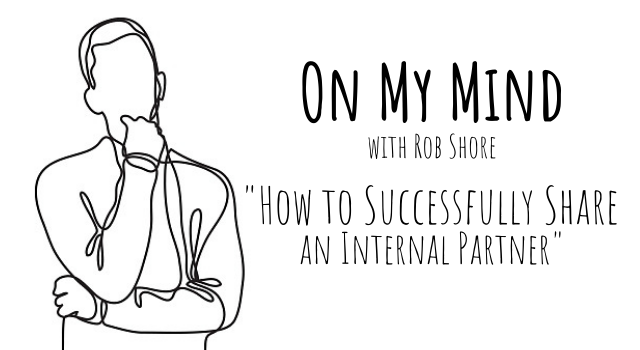Thoughts from Coach Rob Shore about the art, science and lifestyle of wholesaling, for wholesalers and their leaders.
This episode: How to Successfully Share an Internal Partner
What’s on your mind? Email me at rob[at]wholesalermasterminds.com
Subscribe at Apple Podcasts or Subscribe via Stitcher or find us on Spotify by searching The New Wholesaler Masterminds Radio Show in your app or wherever you get your favorite podcasts!
On your smart speaker say, “Play The NEW Wholesaler Masterminds Radio Show podcast”.
Transcription:
Wholesalers, welcome to this episode of On My Mind.
I just got an email, and I thought rather than banging out my response, I would reply to the entire community because I’ll bet you, if you have not had this situation presently, it’s a situation you might find yourself in at some point in the not too distant future.
So this wholesaler said, “Rob, my shop just started hiring a couple of internals.”
This is a firm that apparently did not have internals previously, “And they’re going to be shared on a one internal to two external setup.”
He’s asked me if I had any experience with this.
He was curious about proven models that are known to have had success, how to divide the time and the duties.
The regions that would be in question is a region up in the northeast and a region down south.
What are my thoughts on this?
Well, my first thought is, as crazy as you may think it sounds, and there’s some of you that will think this is crazy, you need to find some common ground with the other territory that you’ll be sharing this internal resource with. And the reason I say this is I’ve frequently seen, and maybe you have too, a case where there is a shared internal resource. And it ends up becoming, not quite infighting, but there ends up being something of a competition to try to capture the most productive time and attention from the internal partner.
And that’s really counterproductive.
And sometimes it might devolve into how you spiff the internal wholesaler versus how the other territory spiffs and motivates the internal partner.
Or there’s a method to the way in which you try to build the relationship which differs from the way that the other territory builds the relationship.
What I’m really thinking about here is how can you and the other territory in some way find some common operating philosophies that are shared between the two territories so that your internal partner doesn’t go out of their mind?
Because serving two masters is very, very difficult.
Can you find common ground around things like:
- what is the protocol for scheduling appointments if that’s a endeavor that internals are used for at all?
- what is the proper procedure for following up after an appointment? How many days? And can it be consistent across the territory?
- How do you feel about prospecting? And can you and the other territory feel the same about how you use an internal for prospecting?
How much consistency can you find between the two territories so that it’s not changing complete operating philosophy when the internal goes to work on your territory versus going to work on someone else’s territory?
Then there was the question of time, and that’s trickier. How much time do we allocate?
But I have seen models successful where the internal partner, and in this case, because we have northeast and we have south, and it would appear, if I read correctly, that there’s a one time zone difference. Not dramatic of course. But is there a way that we can in fact divide up the day?
Can the internal divide up the day so that morning or afternoon or segments of the day are dedicated to one territory versus another?
Or that heavy lifting exercises, like a campaign call out, is dedicated to a particular day for territory one and then a particular day for territory two, making sure there is as much equity between the two territories as possible.
But the number one thing I think that becomes critically important, as different as your business models may be, every external wholesaler is unique in how they run their territories.
But for the good of the firm and for the good of the sanity of your internal partner, finding some common operating model amongst the two territories feels to me to be the most important elements of success when operating two to one.


 Are You Tuned In?
Are You Tuned In? Five Star Service and Attention to Detail: The Benefits to Your Practice with Bruce Himelstein
Five Star Service and Attention to Detail: The Benefits to Your Practice with Bruce Himelstein 8 Core Sales Beliefs of Truly Great Wholesalers with Tony Hughes
8 Core Sales Beliefs of Truly Great Wholesalers with Tony Hughes How To Use Salesforce For Profit (And Remove The Pain): Wholesaler Tech Talk with Kerry Ryan from Salesforce
How To Use Salesforce For Profit (And Remove The Pain): Wholesaler Tech Talk with Kerry Ryan from Salesforce Five Ways to Become a More Conscious Capitalist with Kim Ann Curtin
Five Ways to Become a More Conscious Capitalist with Kim Ann Curtin